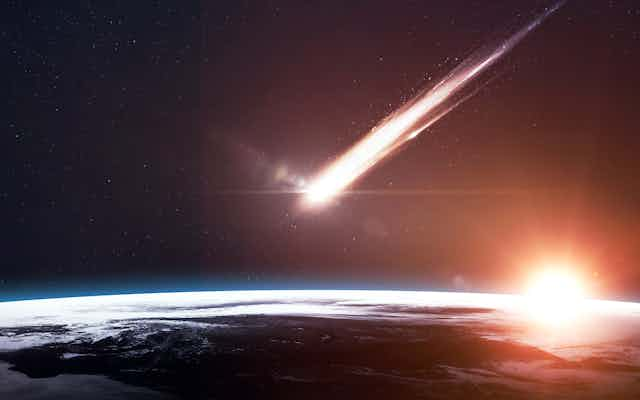The nature of the early Earth’s crust prior to about 4 billion years ago – about half a billion years following formation of the Earth – is shrouded in mystery.
Currently there are conflicting theories as to the structure and composition of the Earth during 4.56 and 4.0 billion years, a period referred to as Hadean. Theories range from a primordial continental granitic crust to a basaltic oceanic crust, to an asteroid-cratered crust.
Precious few traces remain today of that ancient crust for geologists to examine, with the oldest crustal rocks dating back to about 4 billion years.
The discovery in the early 2000s of grains of zircons (zirconium silicate) dating back to 4.4 billion years, found in sediments in Western Australia, has not yet fully resolved this mystery. This is because zircons are resistant to erosion but other minerals and rock fragments are more easily weathered and eroded.
The silica-rich rocks from which the zircons were derived may have come from early granitic crust or they could have crystallised from silica-rich volcanic melts or melt sheets produced by asteroid impacts. So we need more information about what their origin might be.
A dominant theory suggests the Earth collided with a Mars-size asteroid approximately 100 million years after it formed, and that the moon accreted from the material ejected from this colossal impact.
The Apollo missions indicate 3.95-3.85 billion years ago was a period of peak large asteroid impacts, aptly called the Late Heavy Bombardment. The scars can be readily seen on the moon today as large dark basins, for example Imbrium, Crisium and Serenitatis.
In order to shed light on the effects of such impacts on Earth, it is necessary to research the early impact records and study how these impacts affected the primordial crust.
However, the scars from the Late Heavy Bombardment impacts on Earth have been entirely eroded, and the material in the original craters were ejected and scattered around the globe.

Digging up the past
Since the mid-1980s, teams of geologists from the United States and Australia have found the remnants of impact ejecta in sediments in the Barberton Mountains in South Africa and the Pilbara Craton in Western Australia, yielding evidence of impact clusters from around 3.5 billion to 2.5 billion years ago.
This research has so far identified nearly 17 asteroid impact ejecta units older than 2.5 billion years, which have shed new light on the role of extraterrestrial impacts and the evolution of the early Earth crust.
One of the best preserved early geological terrain for discovering ancient impact ejecta is the Pilbara Craton in Western Australia.
Since the early 1980s detailed geological investigations in the Pilbara Craton, led by Dr Arthur Hickman of the Geological Survey of Western Australia, have uncovered a wealth of information on the early Earth which allowed investigation of its asteroid bombardment history.

When an asteroid impact occurs, a large part of the fragmented, fused and evaporated material is ejected into the atmosphere and falls back to Earth, including into the seas and oceans, where it is incorporated in sediments.
The fused and evaporated fractions contain chemical traces of the exploded asteroid. In particular, they contain trace metals and platinum group elements, notably iridium, which are enriched in meteorites.
Condensed impact-ejected vapour forms melt globules and glass spherules referred to as microkrystites.
While the original impact craters were long ago destroyed by tectonic, volcanic and erosive processes, rare relics of the ejecta can still be found in nearby sediments.
To date, only a small part of the impact record has been uncovered, due to the difficulty in identifying traces of impact ejecta in the field.
Evidence has been slowly pieced together showing a cluster of asteroid impacts occurred around 3.2 billion years ago, triggering an abrupt transition in the structure and composition of the crust in parts of the Earth.
This transition is seen in both South Africa and the Pilbara. This suggests that very large asteroid impacts had a major effect on the evolution of the early Earth crust.
Ancient impact

In 2014, Arthur Hickman of the Geological Survey of Western Australia and I searched for further evidence of asteroid impacts in a drill core from the Marble Bar region in the Pilbara Craton, finding traces of ejecta associated with an ancient tsunami triggered by the impact.
The age of the ejecta was determined to be 3.46 billion years thanks to the knowledge of the isotopic ages of underlying and overlying volcanic layers.
The oldest known impact ejecta deposit is a 3.47 billion years old spherule unit located in the Miralga Creek area about 40 kilometres west of Marble Bar, discovered by Don Lowe and Gary Byerly. The newly discovered unit is thus the second oldest known to date.
Geochemical analyses used a range of techniques, including electron microscopy and mass spectrometry, to confirm that the spherules we found contain chemical components of extraterrestrial origin.
This discovery of traces of Earth’s second oldest impact helps connect the dots with other evidence of impacts around the world, and thus piece together the early evolution of the Earth’s crust.

